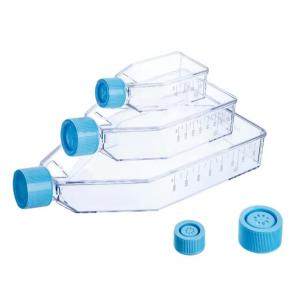
Add to Cart
Sterile Plastic Cell Culture Bottle With Vented Cover Cell Culture Flask T25 T75 T175
Description:
The engraved graduation on both sides helps users to fill accurate medium volume. Marking area is made to identify flasks for different purpose and ridges on the top make flask easy to stack. Sorfa angled design of neck is easy for pipette access into touch each corner of flask.
Caps are categorized to plug seal cap and vent cap. Plug seal cap usually applies to airtight culture, however, it’s suitable for open culture when unscrewing cap. Vent cap is designed for open culture for it includes a hydrophobic membrane of 0.2 um. Membrane prevents gas from contaminating in the process of exchanging. It’s recommended to use CO2 incubator for vent cap, special for long-term cell culture.
For TC surface treatment, flasks are available for suspension culture and adherent culture to meet global market need. All Sorfa cell culture flasks are packaged in bags with sterilization, RNase-free, DNase-free and Non-pyrogenic.

Features and Advantages:
1.Canted neck styles.
2.Graduation on both sides.
3.Has a frosted writing area.
4.Sterilized by gamma irradiation.
5.Certified nonpyrogenic.
6.Shelf life: 3 years
7.Designed with a mouth that gives easy access to entire growth surface.
8.The cap well matches the bottom to keep stacked flask stable for best use of incubator space.
9.Improved adhesion and cell proliferation.
10.Improved growth of primary cells.
FAQ:
What is the function of the cell culture flask?
Cell/tissue Culture Flasks provide excellent performance in initial cell adhesion and proliferation via special surface treatment for adherent cell. Filter prevents invasion of fungi and bacteria, while gas permeable.
What flask is used in cell culture?
Cell culture flasks are an important component for enabling the successful growth of cells and tissues. Culture flasks vary depending on the growth conditions of the cell types of interest. The most common flasks include flat-sided flasks, spinner flasks, and Erlenmeyer flasks of varying sizes.
How do cells attach to the culture flask?
For good cell attachment the hydrophobic polystyrene surface must be modified to a more hydrophilic surface. This allows cell attachment proteins (vitronectin and fibronectin) found in the serum containing culture medium to adhere and spread on the vessel bottom, thus providing a better surface for cells to attach.